|
Growing a garden in an apartment or other small space is the ultimate test of plant growing ingenuity. When most people think of growing something indoors they think they need a nice sunny window to put the plants in. While a bright sunny window is nice to have it is by no means the only way to grow a garden in an apartment anymore.
With the advent of low cost, long lasting LEDs you can grow a garden just about anywhere without it costing a substantial amount of money. Just as an example you can see in a picture below where I grew cherry tomatoes and salad greens all winter long in an otherwise very dark room. This room hardly got any daylight into it and certainly none on the wall where I put the pots.
If you want to grow a garden inside then what you want to do is maximize efficiency in the following ways,
Lights When it comes to growing food inside I find it is best to start with your light setup. You want something that is adjustable in height so it can be raised or lowered according to plant height. It is important to keep lights just above the plant you are growing because this will get the most light to impact the plant leaves. Even with today's LEDs you still need to be close to the plant to offset the fact that light bulbs are not the Sun. Light systems can be purchased commercially like this one or you can make your own from DIY parts. The commercial bought systems are not cheap but they come with all the bells and whistles and come with bulbs specifically tuned to produce light in the wavelengths plants need for photosynthesis. A DIY system is not for the faint of heart and I do not recommend them unless you are comfortable with doing your own wiring. That wiring can be as complicated as actually wiring up an entirely new light system or just modifying an existing one. The one seen in this photo below was my approach since I could get the parts for a very low cost. It consists of an old bathroom vanity light wired up to be plugged into a wall receptacle instead of being hardwired.
Just to reiterate if you are not confident in your ability to do electrical wiring or you live in a location that doesn't allow it,
DON'T DO THIS and I am not liable if you do and something bad happens. If you assemble your own grow lights you can either do something like I did you can use what I call a shop light setup. Doing it this way can be nice because you can get the same LED technology in these and they are built in a way that puts light where you want it. You can also get these with a receptacle plug pre-installed so that means no wiring for you which can be a stress reliever. When you buy the bulbs make sure to get ones that are at least 100 watts and in the daylight part of the light spectrum. These bulbs will put out a bright white light instead of the softer more yellow light usually found in most home lamps. An example of what I mean for the standard A21 bulb is below.
Growing Medium
The choice of what to grow your plants in can have a dramatic effect on the cost of the setup and the ongoing effort to make it work. In terms of expense the bottom of the shelf is just regular potting soil you would use in a pot. Most potting soils are soil less and are instead a mixture of organic and inorganic parts. Some of the most common potting soils are made from peat moss, vermiculite, and perlite which are all great at holding water and nutrients for the plant to use. The next step up is to use a hydroponic system that flushes a nutrient rich water over plant roots periodically. This system requires something for roots to anchor on like, clay pebble, coco chips, pine shavings or just plan old river rock. These systems are nice because they tend to be lightweight unless you use rock and you get very good production when compared to a potting soil setup. They do come with more expense because you have to supply extra nutrients, buy pumps and timers to regulate water flow and they use more electricity than a potting soil system. The step up from that is aeroponics which is basically hydroponics that does away with the growing medium altogether. It used fine misters to spray plant roots with a fine nutrient rich mist. It can work great when it works but this system is highly dependent on nothing going wrong. A power loss or a water supply failure causes the roots to dry out in minutes and you can lose a crop just as fast. So aeroponics is not for the faint of heart or for people that like to set it and forget it. To put these systems in terms of ease of use and likelihood of failure I would put them in the same order as expense. The addition of a water/nutrient holding medium in the first two systems reduces the chances of total failure. You have more time to catch and fix whatever is going wrong in the system. What I would do If I was a new indoor gardener I would set up the following system. I would use a soilless potting soil with a built in catch basin to hold extra water. I would place them under pre-purchased shop lights because of the ease of setup and the ability to raise and lower the lights easily. If I had the room I would multiple shelves of produce from floor to ceiling with 3 feet between each shelf. This should give enough room for most plants to grow while providing clearance for the lights. The plants I selected would most likely be any or all of the following,
I picked them because they continually produce and they don't need any pollination to produce. Hopefully, this gives you some ideas or inspiration to start growing your own indoor garden this winter so you can enjoy fresh produce all winter long.
0 Comments
Having a garden is not just for those who have large plots of land that they can till up and plant seeds in. Even someone with no more space than a deck can have a bountiful container garden that can produce just as much and in some cases more than a garden planted in plain old dirt. This is possible because you can tailor the soil medium for maximum growth and place the pots where they can get the perfect amount of heat and sunlight. There are a few things to consider when establishing a container garden.

Containers
There are two basic categories of containers you can use for planting a garden on a deck. Pots Planter boxes. I seperate them out because pots come premade in many different styles, materials, sizes and can be moved once full. While planter boxes are typically built on site and are too large to easily move once they are full of soil. Pots You can get pots these days in many sizes and materials. They can range in price from cheap plastic to more expensive terracotta and ceramic. In my deck garden I mostly use terracotta pots for the following reasons,
Plastic pots can have some benefits as well as being cheaper than terracotta in most cases and are better at holding moisture for people who water infrequently. Pot Size When it comes to container gardening for most plants bigger is always better. This is because the more soil or other growing medium you provide the better the plant will grow. I dont grow anything in a pot smaller than 12 inches now and most of my pots are actually bigger than that. Smaller pots can be quite successful for herbs but keep in mind that if you vary your pot size too much it can play hell with a watering timetable. Small pots on hot days in the sun can need water multiple times a day while larger pots suffice with one watering a day. If you are starting from scratch I would try to pick a once size pot to use so that you can better predict what you watering needs will be. If you want to vary from that once size go bigger since that will in most cases need less watering than the smaller one. 
Planter Boxes
If you have the space and a good sunny location for them planter boxes are the way to go in my opinion. They will cost a bit of money and time to build and install but the benefits are worth it if you are serious about having a deck garden. Planter boxes are much better at holding water and providing larger spaces for plants to root into. This will result in stronger plants that need less frequent watering to establish and maintain good production. There are many shapes, styles and materials to build planter boxes out of treated/untreated lumber. Plastic panels, metal watering troughs, old fridges (seen it) pretty much anything you can think of using. I made mine from untreated lumber coated in many coats of raw linseed oil. What to plant You can plant anything you want in container gardens but there are things that will do better in a traditional garden. In my experience the following garden plants are good for pots,
If you have large planting boxes than maybe you can spread out into other crops like,
Watering You can go two ways with watering your container garden. You can water by hand every day or you can set up a timed irrigation system. Both systems have their pro’s and con’s. If you hand water it will most likely happen everyday even if it rains since rain typically can’t get enough water into the pots. It puts you out in your garden everyday which is great for monitoring plant growth and when it comes to harvesting but it does take time everyday. A timer controlled irrigation system is great for those of you with busy lives. It will water your plants automatically once it is set up and all you need to do is check it once a week to make sure it is still working right. This way has a lot more upfront cost and setup time but it is nice to be able to relegate watering duties to a timer. So now that you have my take on what you need to know to start a container garden it is time for you to give it a try yourself. The options and ways to do it are endless so you need to figure out what works best for your situation. If you have any questions about this, send me an email and I will help you out as quickly as I can. For more information on how to start a container garden check out some of my other articles here on the Green Living Library. Sources https://lancaster.unl.edu/hort/articles/2002/typeofpots.shtml Its been a rocky start so far with below average temperatures and lots of rain but the 2020 garden is officially in the ground and growing.
Hopefully it stays a bit drier than last year so I wont have as many powdery mildew issues. Below is a gallery of some of the pictures from the year so far. To kick off my series about growing your own food I am going to start with the way I am most familiar.
Growing a garden in an average urban back/front yard. Growing your own food on an urban lot comes with its challenges as well as benefits. You obviously lack space that you would get on a larger piece of land but what you gain is easy access to water and immediate proximity to your garden. This walkout your back door kind of access makes it really convenient to do everything. From planting and maintaining to harvesting your produce, having your garden just 10 steps from your door makes it really easy to garden. |
AuthorHello my name is Josh Larson and I am the creator of the Green Living Library. Here on the blog you will find updates to content found in the Green Living Library as well as stories from those living the sustainable life already. Archives
December 2021
Categories
All
|








